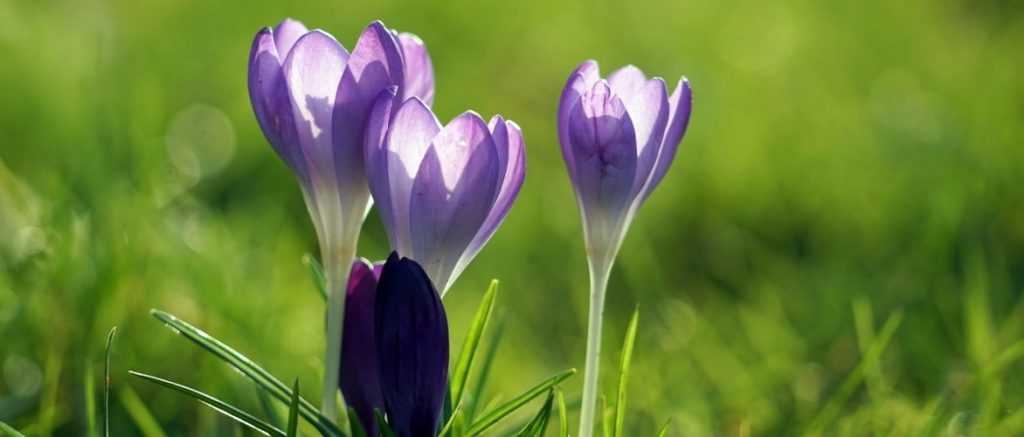
Spring Crocus: Planting, Growing and Caring
Contents
The crocus in a few words
- It’s one of the very first flowers of spring!
- It offers delicate white, purple or yellow blooms.
- Crocus is easy to grow, hardy and rarely affected by diseases. It mainly needs well-drained soil.
- It’s the perfect plant for flowering lawns or beneath trees! But it also grows well in pots or rock gardens.
- It can naturalise and form vast carpets of flowers!
Our Expert's Word
The crocus is a bulbous perennial that flowers very early in spring, sometimes even at the end of winter. It is a flower of rare simplicity, yet its colours and contrasts appear meticulously crafted. It pierces through the snow and awakens the garden, instantly making us forget the cold and gloom of winter! It is touching in its fragile and delicate appearance. This is a plant with gentle forms and extremely fine foliage.
The crocus requires little attention: it is easy to grow, very hardy, and tolerates poor soils! It only needs well-drained soil and sunlight. Moreover, after flowering, it goes into dormancy and requires no further care. Once established, it naturalises easily and can form vast carpets of flowers! Crocuses fit effortlessly into the garden, whether in the lawn, a rockery, or a planter. They take up no space!
At the end of winter, it stands ready, its flower buds poised to bloom at the first rays of sunshine, at the first signs heralding spring… And then, an explosion of colour! The carpets of Crocus tommasinianus covering the lawn, enhancing the base of trees, bringing colour and life to the garden. To quickly forget winter and move on to brighter days! A new year begins in the garden…
Once its flowering is over, it will enter dormancy and fade into the background. It will humbly make way for other plants… only to repeat the same spectacle the following year! What a joy to rediscover it each year, as if it were keeping a springtime appointment with us!
Botany
Botanical data
- Latin name Crocus sp.
- Family Iridaceae
- Common name Crocus
- Flowering between February and April
- Height between 8 and 15 cm
- Exposure sun to partial shade
- Soil type well-drained
- Hardiness -15 to -20 °C
Crocuses are perennial plants that grow in meadows and light woodlands, mainly in mountainous regions. They are found in Europe, Asia, the Middle East and as far as North Africa. Many crocuses originate from Eastern Europe and the Balkans. In France, there are six wild species, two of which are found only in Corsica!
There are nearly 80 species of crocus. These are perennial plants with corms (pseudo-bulbs serving as storage organs). Most of them flower in spring, with a few blooming in autumn. The crocus belongs to the Iridaceae family, which includes 1,800 species, mainly herbaceous, such as Iris, Gladioli, Freesias and Crocosmias. The name “autumn crocus” is mistakenly given to Sternbergia lutea, which doesn’t even belong to the Iridaceae family. The crocus can also be confused with colchicum.
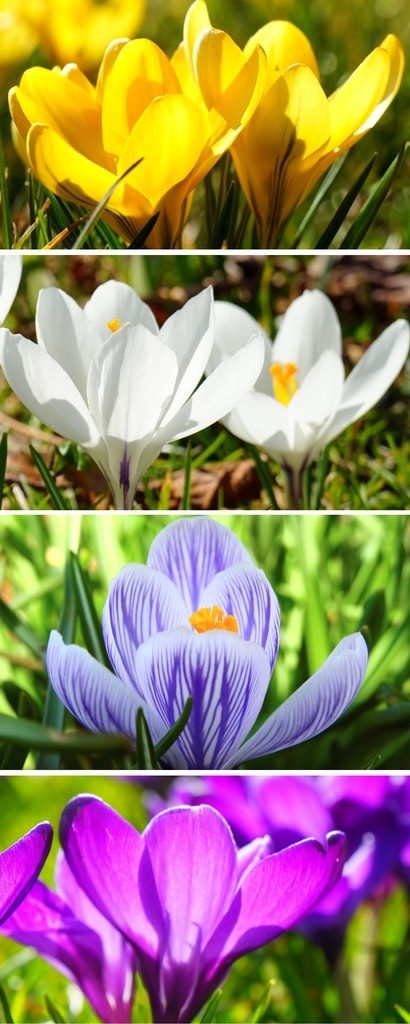
Crocuses offer a palette of very bright colours!
Its name comes from the Greek krokos: saffron. Indeed, because saffron comes from a crocus, Crocus sativus. It is obtained by harvesting the orange-red pistil. It is the most expensive spice as it takes about 150 flowers to gather just one gram! Since this crocus flowers in autumn, we won’t discuss it here.
There are two main categories of spring crocuses: Dutch hybrids, large-flowered varieties derived from Crocus x vernus, and botanical crocuses which flower earlier (sometimes as early as January or February!) and offer small flowers with a more natural appearance.
Crocuses are small plants measuring between 8 and 15 centimetres in height. They don’t take up much space in flower beds but can form an impressive carpet of flowers! This is the case with Crocus tommasinianus. They are best planted in groups. It is common for crocuses to naturalise in the garden!
Spring crocuses flower from late winter, between February and April… sometimes even as early as January! They can pierce through the snow! As soon as temperatures warm up, the flower buds begin to open. Flowering usually lasts between ten and fifteen days. The flowers open with the sun: they close at night and when the sky is grey… making the crocus act as a barometer!
The flowers of crocuses are flared, cup-shaped, and remind us of the flowering of colchicums. Their soft shapes give them a touching, fragile quality. They are composed of six tepals (undifferentiated petals or sepals). They can be white, purple or yellow. They are often very bright! The ‘Mammoth’ series brings together varieties selected for their large flowers. At the centre of the flower, the orange-yellow stamens offer a striking contrast against the petals, especially when the latter are white or purple!
Some varieties, particularly those derived from Crocus chrysanthus, are fragrant! Their flowers release a light honey scent.
The leaves of crocuses are narrow and linear. They have a lighter central vein and often measure 10 to 15 centimetres in length. Generally, they grow at the same time as the flowers. But after flowering, they elongate! Then, in late spring, the foliage yellows and the plant goes into dormancy. It will then require no further maintenance. There’s no need to water it; on the contrary, the bulbs prefer to stay dry!
The crocus produces corms: these are pseudo-bulbs composed of a swollen stem surrounded by scales. As storage organs, they allow the plant to store nutrients to spend part of the year dormant and then reflower in spring. It is easy to propagate crocuses by collecting these corms.
Crocuses are sometimes sold in mixtures that combine a large number of bulbs of different varieties. This is a good solution for flowering a lawn, but you may prefer to choose the colours yourself to create a harmonious ensemble… and thus limit yourself to a more restrained palette.
Botanical species:
- Crocus chrysanthus
Native to Eastern Europe, this species flowers earlier than Dutch hybrids. Its flowers are also smaller, giving them a more natural style. It bears yellow flowers but has given rise to many varieties with flowers that are sometimes white or blue, for example ‘Blue Pearl’.
- Crocus vernus
This crocus bears purple or white flowers with yellow stamens. It is found in mountainous regions, in Eastern and Central Europe, from Western Russia to Italy. It has given rise to many Dutch hybrids with very large flowers.
Native to Eastern Europe, this very prolific crocus spreads on its own and tends to naturalise! It is one of the first to flower, sometimes as early as February. Moreover, unlike other varieties, it tolerates shade! Thus, you can grow it in woodland. Its flowers are lilac or purple-red.

The blooming of crocus flowers!
The main varieties of crocus

Crocus vernus Pickwick
- Flowering time April
- Height at maturity 15 cm
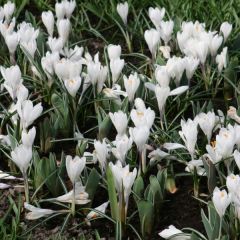
Crocus vernus Jeanne dArc
- Flowering time March, April
- Height at maturity 15 cm
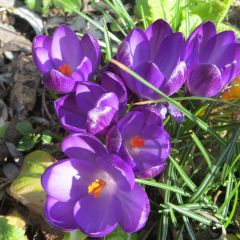
Crocus tommasinianus Ruby Giant - Early Crocus
- Flowering time March, April
- Height at maturity 15 cm

Crocus vernus Remembrance
- Flowering time March, April
- Height at maturity 10 cm
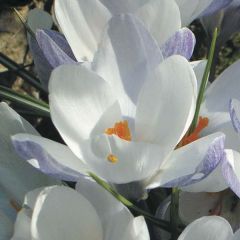
Crocus chrysanthus Blue Pearl
- Flowering time March, April
- Height at maturity 12 cm
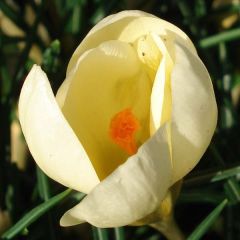
Crocus chrysanthus Cream Beauty
- Flowering time March, April
- Height at maturity 10 cm

Crocus ancyrensis
- Flowering time March, April
- Height at maturity 10 cm

Crocus Prins Claus
- Flowering time March, April
- Height at maturity 12 cm

Crocus chrysanthus Fuscotinctus
- Flowering time March, April
- Height at maturity 10 cm

Crocus sieberi Tricolor
- Flowering time March, April
- Height at maturity 10 cm
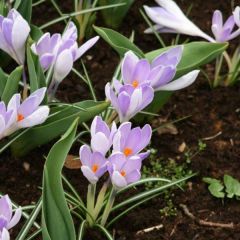
Crocus vernus Vanguard
- Flowering time April, May
- Height at maturity 10 cm
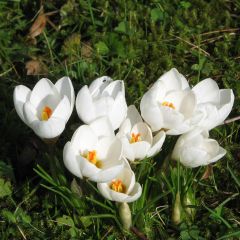
Crocus chrysanthus Snow Bunting
- Flowering time March, April
- Height at maturity 10 cm
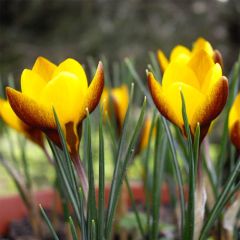
Crocus chrysanthus Zwanenburg Bronze
- Flowering time March, April
- Height at maturity 15 cm
Discover other Spring Crocus
Planting crocuses
Where to plant?
We recommend planting your crocuses in groups, with at least five bulbs together, ideally around ten. You can cluster them to create colourful patches in a lawn or scatter them more randomly.
Crocuses are easy to grow. There are just two conditions for success: a well-drained soil and sunlight! They dislike moisture and will thrive in a south-facing spot. However, Crocus tommasinianus grows well in shade.
Crocuses prefer light soils! They can tolerate stony and poor ground. If your soil is clay-heavy, improve its drainage by adding pumice or gravel. It’s not a problem if the soil dries out in summer—quite the opposite! Since crocuses are dormant then, they prefer staying dry. Avoid planting them, for example, under an automatic lawn sprinkler system or near plants requiring regular watering, as the bulbs may rot.
You can also grow them in pots or containers, alongside other bulbs, or in a rock garden—or even on a green roof! In flower beds, to protect them, plant them among perennials that will cover them, such as ground covers or plants that start growing once the crocuses have finished flowering.
When to plant?
Plant your crocuses in autumn, between September and November, avoiding frost periods. Planting them earlier will result in slightly earlier and better-quality blooms compared to late November or December planting.
How to plant?
Planting crocuses is quite simple. Space the bulbs about 10 cm apart. We recommend using a bulb planter.
Scatter the bulbs randomly on the ground for a natural look—feel free to toss them and plant them where they land! Dig a small hole for each bulb, about 10 cm deep. If needed, improve drainage with a thin layer of gravel or clay pebbles. Place the bulbs the right way up, with the pointed end facing upwards. Backfill with soil and firm gently. Watering is usually unnecessary.
Don’t hesitate to plant your bulbs densely, digging a wide hole and placing them all together, side by side but not touching. This will create beautiful splashes of colour! If planting in a lawn, lift a turf patch, plant the bulbs, then replace the turf. This way, you won’t damage your grass!
Use markers to remember where you’ve planted your bulbs and avoid accidentally digging them up. If planting crocuses in a flower bed, we recommend planting all your flowers at the same time to avoid damaging the bulbs with later digging.
Watch our video guide on planting crocuses with a bulb planter!
Container planting:
You can grow crocuses in pots or containers. Use a wide, shallow pot. Drain the base with a layer of gravel or broken pottery. Fill with compost mixed with a little sand. Place the bulbs pointy-end up, fairly close together, then cover with substrate. Firm gently.
Also read: Growing crocuses in pots.
Maintenance
Crocus is incredibly easy to grow and requires almost no maintenance. The key is to avoid excess moisture and refrain from cutting back the foliage before it has completely withered! Generally, maintenance simply involves removing spent flowers and dividing the corms after a few years if flowering declines, to rejuvenate them.
Crocuses are hardy and rarely suffer from diseases or pests, except for rodents (squirrels, mice, voles, and field mice), which delight in digging up and nibbling the bulbs! Protect them with wire mesh or plant them alongside other bulbs that rodents avoid—such as snowdrops or daffodils—as these are toxic to them.
Once flowering is over, the leaves lengthen and then turn yellow. The crocuses are replenishing their reserves to bloom again the following year… So resist the urge to cut back the foliage until it has completely dried out! Wait until the plant is dormant before mowing the lawn.
Leave your crocuses in place after flowering. Once dormant, they will require no further care. There’s no need to water them—quite the opposite! They dislike moisture, as the bulbs may rot.
To encourage earlier flowering, you can force the bulbs by exposing them to a cold period. Plant them in pots in October, using a light, well-draining substrate, then place them in a cool (no warmer than 10°C), dark location—such as a cellar or garage. Water regularly. After two months, when the first shoots reach 5 to 10 centimetres, bring them out into room temperature and place them in a bright spot near a window. This way, you can enjoy blooms in the heart of winter!
Propagation
Crocuses have a natural tendency to naturalise. This is particularly true of Crocus tommasinianus, which self-seeds and forms colonies, creating veritable carpets of flowers. We recommend propagating them by dividing the corms, a much more reliable and quicker method than sowing seeds.
Dividing Corms
By dividing crocus corms, you can easily and quickly obtain new plants.
Crocuses multiply naturally by producing new corms. We advise dividing your crocuses every four to five years. This helps rejuvenate the clumps and makes them more vigorous.
Divide the corms in late spring or summer, starting in May. At this time, the foliage turns yellow, and the plant enters its dormant phase. Dig up the corms with a spade, taking care to dig wide enough to avoid damaging them. Separate the small bulbils that have formed beside the original bulb. Replant them in groups, with the pointed end facing upwards, about ten centimetres deep. Cover with soil and firm down. Watering is not necessary.
Sowing Seeds
You can collect crocus seeds and sow them, but this method takes time, and you may have to wait two to three years before they flower. Additionally, if you sow horticultural varieties, the resulting flowers may differ slightly in colour from the original.
In spring, harvest the seeds and sow them immediately. Fill a pot with compost, leaving a few centimetres at the top. Scatter the seeds evenly and fairly densely, then cover them with a thick layer of compost—they should be sown quite deep. Water and place the pot under a cold frame. You’ll need to wait two years before planting the young seedlings in the ground.
Association
Crocus allows you to enjoy flowers as early as late winter. Take advantage of this to create a colourful flower bed very early in the season! Pair them with other early-flowering bulbs, such as daffodils or chionodoxas. You can also add some Lenten roses or English primroses.
Crocus is perfect for brightening up a lawn. Choose Crocus tommasinianus, as it tends to naturalise! It will cover the ground with a beautiful lilac carpet! Tolerating partial shade, it can even be planted in woodland areas and flower at the base of trees. Snowdrops and spring snowflakes will complement it beautifully. Enjoy the yellow blooms of Eranthis hyemalis to add colour and brightness to your garden!
Crocus adapts to various uses: you can grow them in containers alongside other perennials or bulbs. They can also be planted in rock gardens, or even on a green roof! This is thanks to their drought resistance and ability to thrive in poor soil. Pair them with alpine plants or succulents, such as saxifrages, houseleeks, or snow-in-summer.
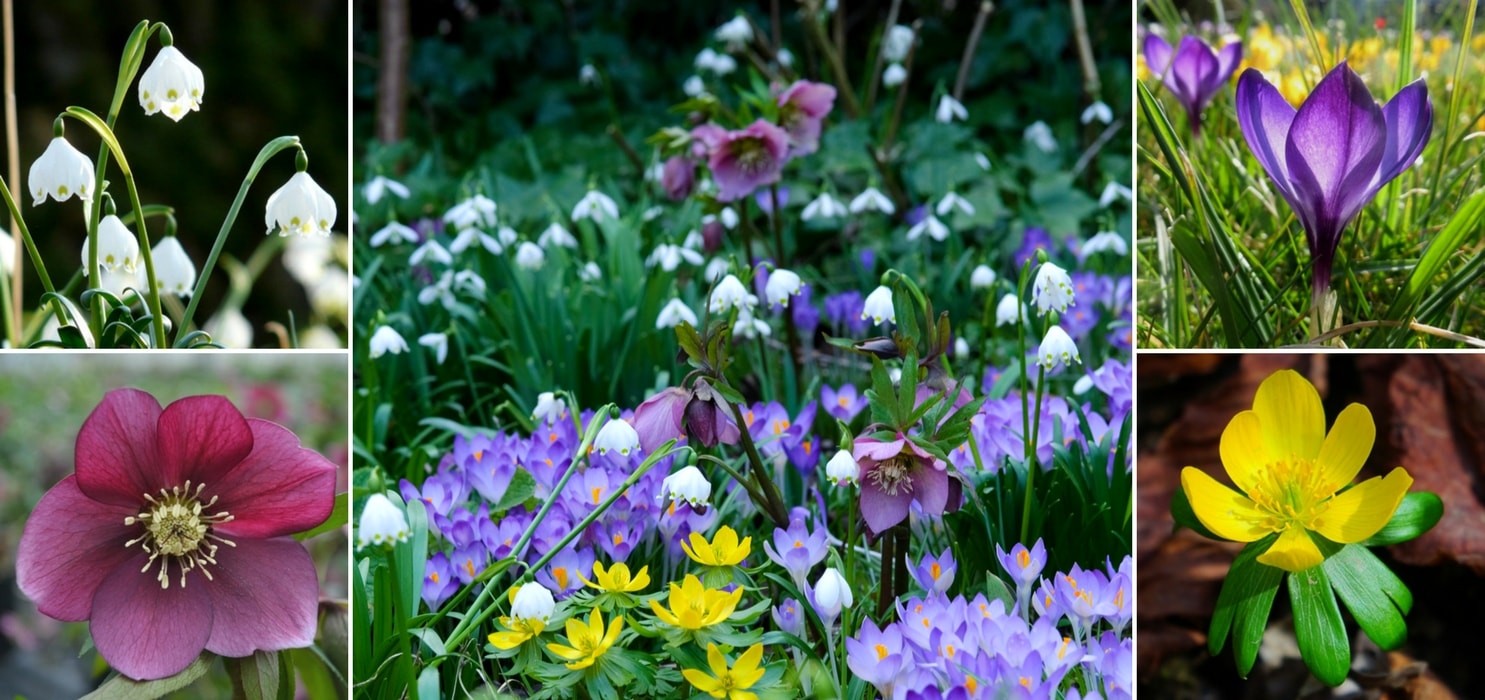
A spring woodland scene featuring Leucojum vernum, Helleborus x hybridus, Crocus tommasinianus, and Eranthis hyemalis! (Photo credit: GAP Howard Rice)
Also check out our advice sheet: “Crocus: How to Choose and Pair Them in Your Garden”
Did you know?
In the language of flowers, crocuses carry different meanings depending on their colour. Yellow-flowered varieties convey a message of apprehension and concern regarding romantic feelings, symbolising the need for reassurance. White crocuses express the joy and happiness associated with youth, while blue ones represent budding love.
In Greek mythology, Crocus was a man in love with the nymph Smylax. As she remained indifferent to his charms, the gods transformed him into a crocus to ease his sorrow.
In another version, Crocus was a friend of Hermes. The latter accidentally and fatally wounded him during a discus throw. Three drops of his blood fell to the ground and gave rise to a remarkable flower, which was named after him – the Crocus.
Useful resources
- Our wide range of spring crocuses!
- Our video tips – Planting crocuses with a bulb planter
- Advice sheet: “Crocus, how to plant them”
- Advice sheet: Which bulbs to grow indoors?
- Advice sheet: Bulb sizing: understanding to choose better
- Advice sheet: 6 bulbs to naturalise in the garden
- Advice sheet: 5 bulbs for early winter flowering
- Crocuses by flower colour: Yellow-flowering crocuses, the best varieties, The best white-flowering crocus varieties for your garden, Top 5 mauve-flowering crocus varieties
- An article by Didier Willery, published in L’Ami des Jardins et de la Maison: First crocuses to herald spring
Frequently asked questions
-
I planted some crocuses, but they're not growing. I can't find them anymore!
Your bulbs have likely been eaten by rodents (mice, voles, field mice or squirrels), who take great pleasure in digging them up and nibbling on them! To protect them, we recommend installing wire mesh or planting other bulbs among your crocuses that they will avoid, such as snowdrops or daffodils. Plus, these plants flower at the same time and pair perfectly with crocuses!
If they're not growing, it's also possible that the growing conditions aren't suitable for them: soil that isn't well-draining enough, a bit too much moisture... the bulbs may then rot! Crocuses prefer to keep their feet dry, especially when they are dormant.
-
My crocuses aren't flowering, or very little. What should I do?
If your crocuses' flowering is declining, you should divide the corms to rejuvenate them. Carry out this task in late spring, around May, when the plants enter their dormant period. Dig up the corms, separate them, and replant them. We recommend dividing them every four to five years.
If your crocuses struggle to flower, it may also be due to insufficient light. Apart from Crocus tommasinianus, which thrives in partial shade, most varieties need full sun to bloom! If they're in shade, dig them up and replant them in a sunny spot.
-
The flowering is over. Should I remove my bulbs to store them?
No. Even if you're tempted to dig them up to protect them from moisture or rodents, it's best to leave them in place!
-
Can I plant my crocuses in winter?
Planting is possible in November, possibly even in December, especially if you live in a region with a mild climate. Choose a variety that flowers quite late, among the Crocus vernus (for example, 'Pickwick' or 'Jeanne d’Arc'). It's not ideal, but it's better to plant them even if it's in January rather than storing them for planting the following year.
-
Should I add fertiliser?
No, it's not necessary. Crocuses are undemanding and thrive perfectly well in poor soil. You may add a little fertiliser if you're growing them in pots. But generally, the fertiliser already included in horticultural compost is more than sufficient to meet crocuses' needs.
-
Can I mow the lawn after flowering?
No, you must absolutely avoid cutting crocus leaves! Once flowering is over, the plant builds up its reserves and prepares to go dormant. You should wait until the leaves are completely dry and the plant enters its dormant phase. After that, you can safely mow your lawn.
-
Can I plant in partial shade?
Yes, crocuses can tolerate a slightly shaded position if they can enjoy a few hours of afternoon sun, or if you plant them beneath deciduous trees. If not, choose Crocus tommasinianus, as it copes well with shady spots!
- Subscribe!
- Contents



































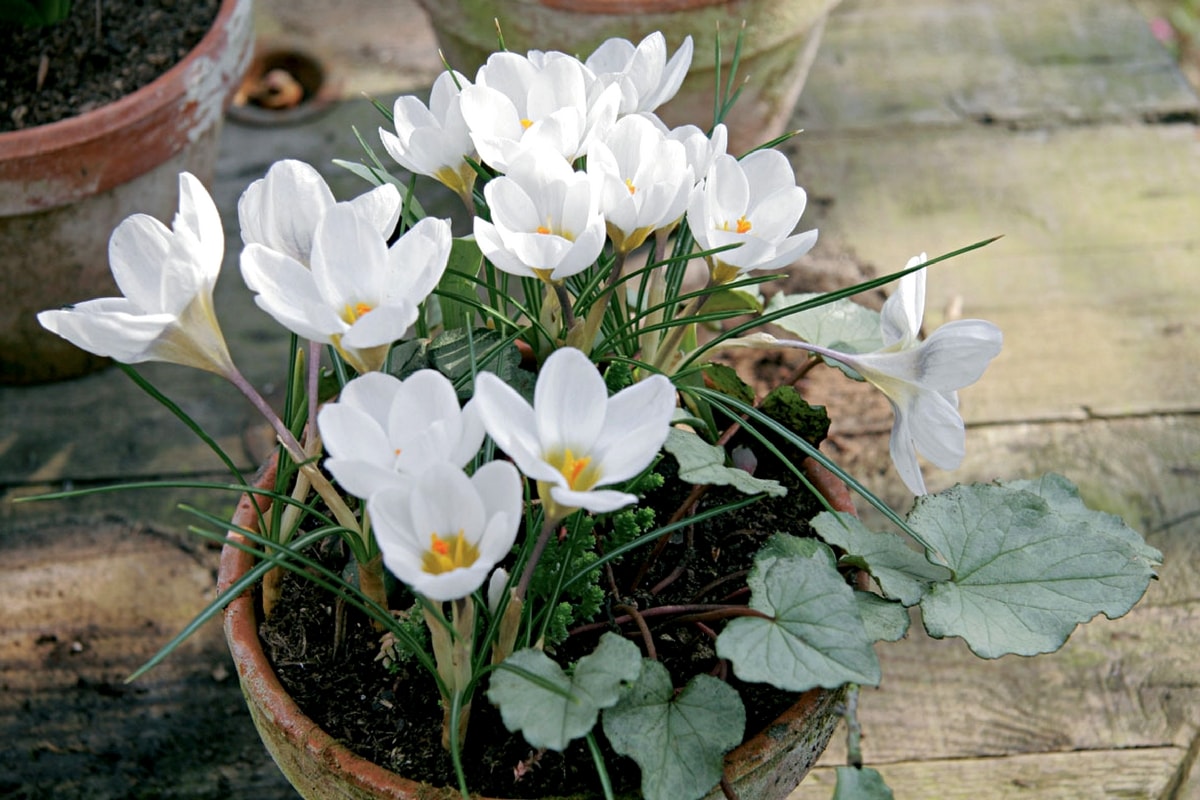

Comments